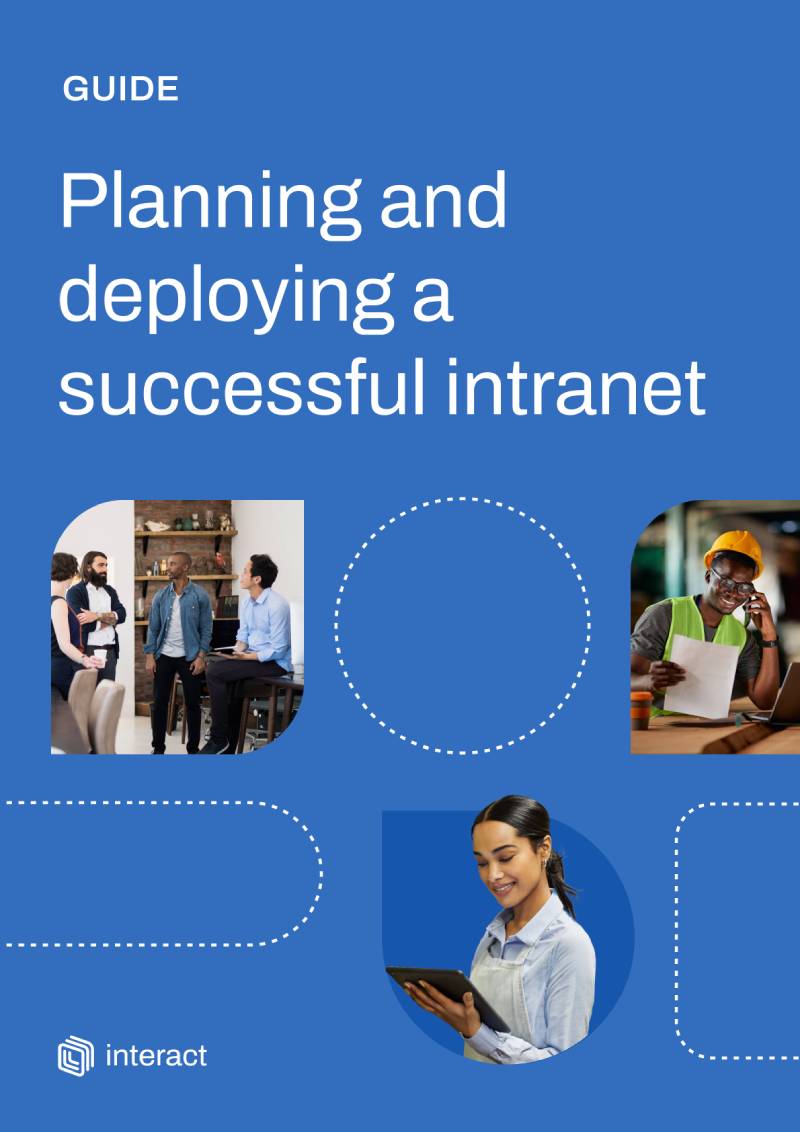The last few months have been tumultuous for businesses and individuals alike. With the return to the office looming, how can you use your intranet to maintain engagement among your employees?
As offices gradually welcome back their employees after months at home, business leaders are keen to get things “back to normal” with a united workforce who continue to be actively engaged with the work that they do.
But the transition to the office might pose some challenges to many workers, understandably. The past few months have been dispiriting, and employees have experienced some difficult situations. These issues have meant that the usual priorities have been sliding down the list in terms of importance. It’s a delicate period in which to tread, but businesses need to reassemble and bolster their employees if they want to keep moving forwards.
This is a time for motivation, encouragement, and leadership in order to get your workforce back to the office, reconnected, and motivated. Doing this presents its challenges, but we’ll demonstrate how using your company intranet can provide the support, automation, connectivity, and workplace culture needed to get your workers back on track.
Why you need to check in on your employees

In order to work out the best ways to welcome your workforce back, it’s important to understand the many different ways that attentions have been diverted. Many of us have had to tend to different situations throughout the first half of this year, whether it’s isolation, domestic friction, ill health, financial worries, or general anxiety. By speaking to your employees, you can begin to build up a picture of circumstances. This exploration will help create a program of ways to ensuring people settle back into the workplace and are happy, motivated, and engaged. So what issues should you expect to encounter on the journey to ‘business as usual’
Focus has shifted

It’s fair to say that the virus and subsequent lockdown took up most of our attention in the first few weeks. Moving the workforce home, changing plans, reworking priorities: all usual business was put on hold. That meant that general comms were discarded for crisis comms. With the main focus being the need to know how the organization would steer through the oncoming months, users were focused on using the intranet for these updates. Now is the time to change direction and use your intranet to look forward. Allow your employees to understand the goals over the next twelve months and hear how the organization plans to ride out the current situation. At this point, it’s recommended that employees recognize how integral they are to this strategy.
Domestic distractions

The en masse move to homeworking created a huge upheaval in many employees’ lives. School closures meant that perhaps for the first time ever, parents were working and schooling their children at home. This multi-tasking took a lot of adjusting, and most organizations were able to facilitate this shift. As some schools welcome back certain year groups, it’s important that senior-level follow the updates and communicate accordingly to those parents in the organization – offering them a chance to return to the office when they have the opportunity.
Job losses, furloughing, unpaid leave

User levels have taken a further hit in the number of workers whose employment has been impacted by the crisis. The intranet has been instrumental in communicating with those affected, providing them with the communications needed to stay in the loop. However, the uncertainty will be impacting a large part of the organization, so it’s essential to use your intranet to communicate appropriately on the latest updates from the government, how the organization is focusing on retention and is minimizing future job losses as much as possible.
Decrease in news

With no socials, no office life, no face-to-face interactions, your organization may have noticed that there have been fewer daily updates to share on the intranet. In fact, departments may have become quite insular, with news generally being shared between employees during video calls and regular catch-ups from home. As you move forwards, kick start the social aspect of your intranet with blogs from senior level, managers, and employees on a range of subject matters. Create video comms about the health and safety dos and don’ts of the office space. Publish the experiences of people who have returned to the workplace. Regular, light-hearted employee engagement ideas from all areas of the business will be welcomed right now.
How to keep your employees engaged using the intranet

Employee morale might have been impacted by the reasons above, but it doesn’t mean that your organization won’t recover from the first half of this year. Considering just how disruptive world events have been in the past few months, its clear our workers have been distracted. However, for the many organizations that have navigated the crisis to the best of their ability, workplace loyalty is at an all-time high. Employees are keen to have stability and regularity back in their lives – and working is key to this.
For those who are returning to their workplace after a period of leave, it is more important than ever to reinstate some kind of normality. This cohort of employees will need a warm welcome back and possibly a mini onboarding program to re-familiarize themselves with processes and procedures – and of course, any new protocol that has been implemented since lockdown. So, how can your intranet support you in getting your teams back successfully?
#1 Feedback is key

Through the use of assessments and pulse surveys, employees are able to feedback to their company on a variety of topics. The result is mutually beneficial: the workforce can have their input, while leaders can tap into the valuable thoughts and feelings of their people. Of course, it’s only truly beneficial in the long term if this feedback forms plans going forwards. And if this is the case, it presents your intranet as a significant asset in the workplace.
If you do need to work on post-COVID re-engagement with your workforce, position your intranet as the main channel for comms in the discussion of returning to the office, and other related topics. HR should work out who has domestic responsibilities that inhibit their return. By running a pulse survey to find out how many employees are comfortable returning to the workplace, you should get a general sense of the mindset among the workforce.
#2 Do you use your intranet to gather?

All hands meetings – an organization-wide business meeting in which an executive report is made to employees and stakeholders – are an integral part of communication within a business. It is here that you invite all workers to access vital information about the running of the company. These meetings provide transparency and foster a strong workplace culture.
Even in post-lockdown, it may be difficult to envisage a traditional company meeting of hundreds of people in a room together. However, digital tools make these types of get-togethers possible for online users, by using Zoom, Microsoft Teams, or any other conferencing software. Using your intranet to host the meeting through Integrations can allow every employee to tune in and get informed about the organization’s future plans that affect them, as well as ask questions.
#3 What integrations do you offer?

The digital workplace can feel like a disparate array of tools all used exclusively of each other. App sprawl can lead to a lot of time wastage, with little in the way of connectedness. In the modern workplace, organizations need to find a way of joining up all these work-critical tools into one place.
By implementing integrations, your intranet becomes the gateway to all the digital services your employees use day-to-day. O365, G Suite, Slack, and Dropbox can all be accessed through your platform, giving your employees everything they need in one place. And your intranet becomes the launchpad for them all, meaning employees go there when they need to work, regardless of where they are. So, if they need to stay at home or work remotely, they are connected through their intranet to the digital workplace.
#4 Are you an information source?

A recent poll discovered that during the COVID-19 crisis, employer communications was the most credible source of information about the coronavirus – above mainstream media, friends and family, and social media. This is an incredibly vital role to play and underlines the duty of care that the workplace has on the individual.
It also reveals to the employer how crucial it is to provide a center for news and updates about any political, financial, environmental, and cultural events that affect work and the worker. Creating a space online where employees can access up-to-the-minute information on matters that are affecting them is a good idea for anyone managing an intranet. This should be fact-checked information update regularly, allowing your intranet to become one source of truth.
#5 Do you reward and recognize?

The psychology behind the value of recognition has been well studied, and it’s imperative that all organizations should practice some kind of recognition program within their workforce. Traditionally, these practices have been top-down: leaders singling out particular individuals for exemplary work and exceptional merit. Nowadays, recognition is more likely to be peer-to-peer, with colleagues giving shout-outs to each other for favors and going out of their way to help.
And the best way of managing this kind of program? Through the intranet, where employees can ‘gift’ each other virtual thanks or tokens. Countrywide Housing, UK’s largest integrated property services group, created a program called High Fives. This initiative was launched across the organization as a way of not only encouraging engagement with the site, but also to highlight great work that may have otherwise passed by unnoticed. It was an incredibly successful, award-winning initiative that has transformed the way employees use the intranet and interact with each other. It can also be a very effective morale booster in these trying times.
#6 Have you gone mobile?

The ability to access your organization’s digital workplace anywhere has been made a priority in the recent crisis. The intranet has been a common link between the HQ and the workforce, which means that it’s important that users can access it anywhere, even to obtain confidential data.
Mobile apps are fundamental in accessing and sharing information, connecting with each other, and receiving updates from the senior level. During the COVID-19 crisis, mobile intranets were fundamental to frontline key workers in hospitals who needed access to newly formed protocols and procedures on the go. Without this critical link, there would be a significant gap in communications with those people who need it most. If your intranet isn’t mobile yet, it’s must be a priority going forwards.
#7 How accessible is your design?

It’s so important to make your intranet accessible to everyone. Web accessibility refers to design that is easily reached and used by people with disabilities, particularly impaired vision, or color-blindness. It also benefits people who are experiencing poor connection. The use of larger text, clear CTA on buttons, easy navigation, and contrasting colors can all be implemented to make the site easier to use for everyone.
Review your homepage and see how many accessibility boxes it ticks. If it’s too ‘noisy’, takes time to load, has faint colors and small typeface, some of your users will struggle to read and use your system effectively. You can check out some more design tips to ensure you achieve the correct accessibility, and therefore increase engagement, here.
#8 What’s your homepage looking like?

An intranet homepage is arguably the most critical part of the system. This is your user’s first impression of the site, and its appearance counts massively in terms of your user’s engagement. When it comes to forming a relationship with it, your homepage needs to be three things: relevant, easy to navigate, and simple.
Ensure you have the critical parts of what you want your intranet to fulfill on your homepage, with useful links to people’s directory, a search bar, and company news updates. Get rid of components that are not pertinent to the user, and anything else that can add to the ‘noise’ of the page. Your users want to access the information they need without any distractions, obstacles, or hindrances.
#9 What processes do you offer your user?

The average business will have several processes that an employee will use. Payroll, expenses, training, and development, onboarding – the list goes on. Organizations with intranets benefit greatly from automating these processes on the platform. Thus, the advantages of an intranet include an increase in accuracy, a decrease in administration for the relevant departments, accessible storage in one place – and it also means your intranet is used for critical processes and procedures.
On the return to the office, it’s a good idea to use your intranet to engage staff on a re-boarding program, where you can provide instructions on health and safety and all COVID-19-related protocol. Providing this on your intranet allows employees to embark on the program while they’re still at home, preparing them with everything they need to know once they’re back in the workplace.
#10 Explore goals and ambitions

There’s nothing quite like a global pandemic to make you re-evaluate your life and career. Many of your employees will be returning to the workplace, feeling a little jaded. With some sense that they are not fulfilling their dreams and ambitions, now is the opportunity for you, as their employer, to explore together what it is that they want.
Managers can schedule one-to-ones and figure out ways that the organization can help; whether that’s a raise or a promotion, a transfer to another area of the business, or even reduce the hours to focus on family life. By helping them improve this area of their lives, your employees engage more with the organization. Your intranet can help with this by being the home of your employee development programs or supporting them working from home, or any other ways your employee wants to adjust their working life.
This has been a period of great change. A business may feel slightly wary at the moment, wading through an unfamiliar set of challenges. But navigating successfully through the turbulence with honesty, transparency, and trust in its people can present it with new ideas on how to go forwards. McKinsey advises to relinquish the traditional top-heavy approach to challenges and redefine how they problem-solve in the new post-COVID age. “What leaders need during a crisis is not a predefined response plan but behaviors and mindsets that will prevent them from overreacting to yesterday’s developments and help them look ahead.”
Using an intranet as an agile tool to re-engage and support the workforce goes a long way towards generating the decision-making, fresh ideas, and new directions needed for all post-COVID organizations. An intranet, used to its full capabilities, is instrumental to the much-needed reinvention of many of today’s companies, armoring them for a new and very different tomorrow.


